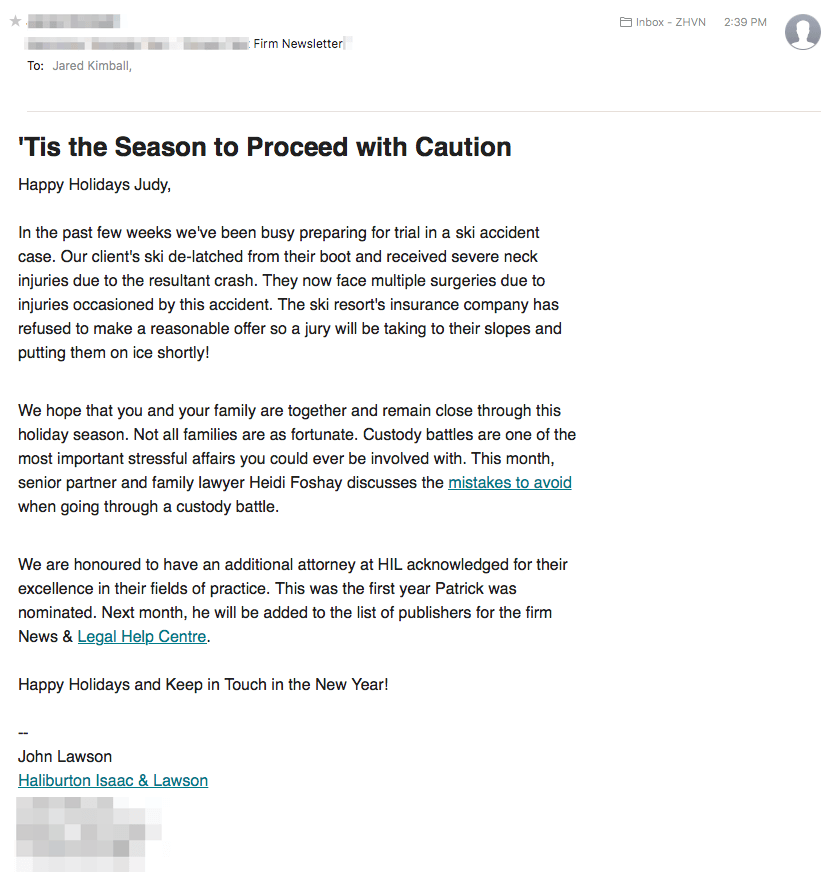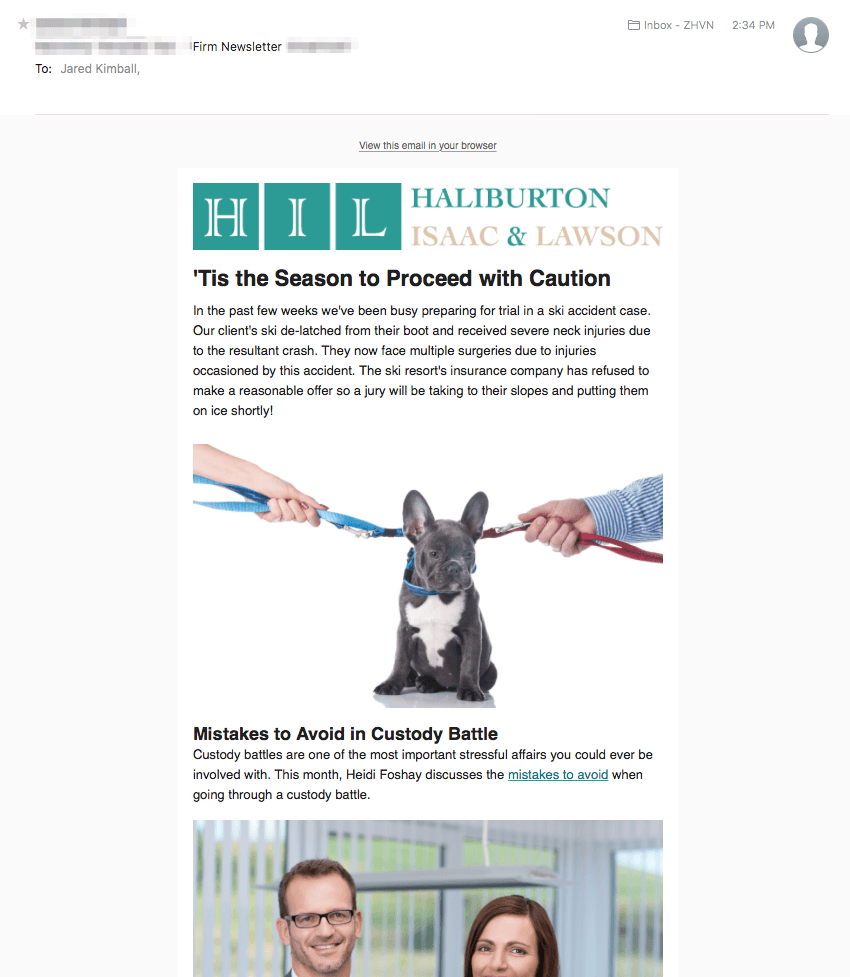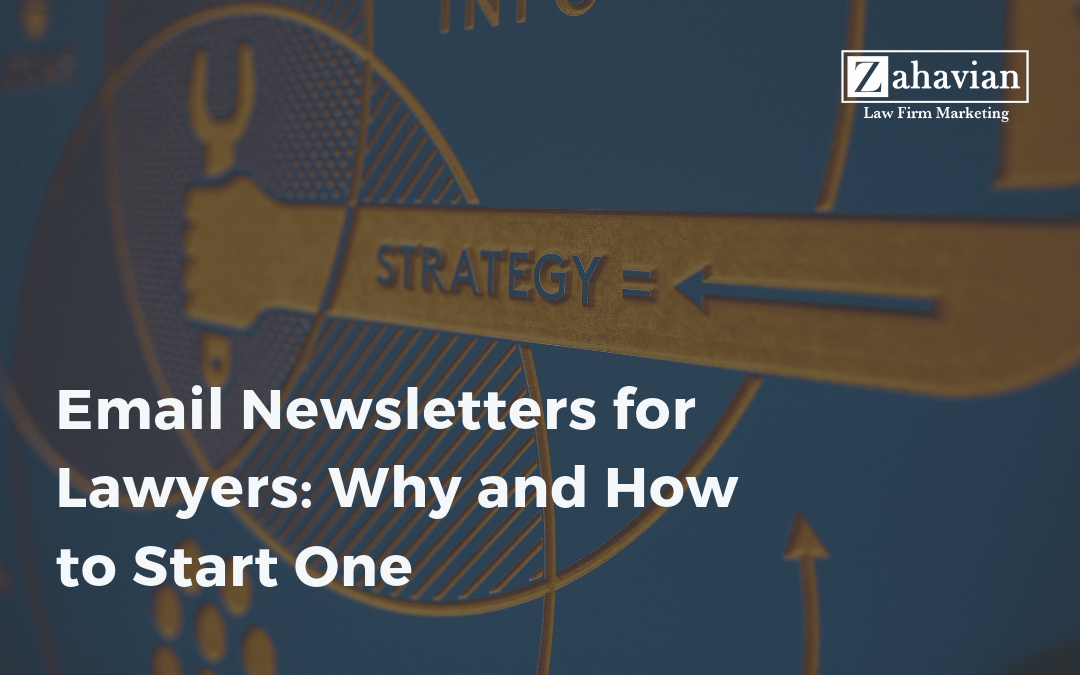Many law firms and attorneys have heard of the idea of newsletter and email marketing. It’s not a new concept to them. However, if you’ve recently been considering new methods for marketing cost effectively and generating more consistent results from your marketing, then you may have returned to the idea of email marketing and newsletters for your legal practice.
In this article, we’re going to aim to answer most of your questions and give you a good rundown of how email marketing can become one of your firm’s most valuable marketing channels and assets. Regardless of your position on newsletters that you receive, after reading this, we hope that you’ll consider email newsletters a little more seriously and start experimenting with how your law firm can implement it to start bringing in new and recurring business.
Why Should My Law Firm Send Email Newsletters?
Lawyers are in the business of talking and dealing with many faces daily, whether it’s your clients, peers, colleagues or prospective clients. It would be a tall order to ask you to recount every single name, face and subject of the contact or meeting. You lead a busy life and balance a tight schedule between home life and the office. You’re not alone. So do your clients and peers.
So how can ensure that you don’t become forgotten when these contacts require legal assistance that you can help them with? Furthermore, how do you leverage this network of contacts to drive referrals if you become a faint memory months or years later when their friends, relatives or acquaintances need your law firm’s services?
The answer is to turn this otherwise forgotten network of contacts – that collect dust in your Outlook contacts list – into your firm’s most consistent, top-performing stream of referrals and a predictable source of new clients and files. By investing in a weekly, bi-weekly or monthly email newsletter, your firm will stay top of mind with your existing audience.
This is incredibly powerful since these are your most loyal and biggest supporters. Many of them already know the level of work and service you provide and would be happy to work with you again or trust your firm to handle any referrals they send your way. An e-newsletter that reaches them consistently will keep your firm and name top of mind so that when they’re in need or the topic arises while they’re talking with a relative or friend, they think of your legal practice first.
What Should a Law Firm Email About?
There are several pain points that many businesses, including law firms, struggle with when creating an e-newsletter. One of the top problems among these is deciding the content of the newsletter deliverable. This is simpler than you may think but will depend on what your practice is already or publishing planning to publish, be it blogs, social media or other forms of content.
- Case Studies and Recent Wins
- Awards and Firm Recognition
- Firm or Staff Member News
- Community Service, Involvement and Sponsorships
- Posts or Articles from your Firm’s Blog
- Common Legal Questions and FAQs
- Write about Newsworthy or In-the-News Content
- Share Legal Related Articles from News & Media Websites
- Changes in the Law
- Feature your Vlogs & Podcasts
- Guides, Forms and Downloads
- Social Media snippets and Legal Jokes
- Promotional Content & Service Pitch
When you start to think about it, there’s a lot your firm could include in a newsletter. It doesn’t mean you should include all or even most of these things. Depending on the voice and style of your firm, you may already be using social media accounts like Facebook. You may post humourous content and comics on legal or lawyer jokes. If so, consider featuring some of the content you share there in the newsletter. Lighten up your newsletter by making your audience chuckle or smile. It’s never a bad idea for people to associate positive thoughts when thinking about your practice.
If your firm is working on a new product or service for clients, something that will make one of your services easier or more affordable, this could be a great way to promote it, keep people updated on developments and receive feedback. Lawyers that have been acknowledged for their work can be featured in the firm news section of the newsletter.
Guides, Forms and Downloads may seem like a strange one. However, it all depends on your area of practice and your desire to approach this type of marketing. If you work in tax law, then you could send out forms or links to PDF downloads for IRS or other forms for people to use. Guides and Downloads are also used as lead magnets, which are used in email marketing to persuade new visitors and prospective clients to sign up for your firm’s newsletter. People who are on your list should receive these from time to time, so even people who see little value elsewhere in your firm’s newsletter, stick with your mailer for these helpful forms and downloads.
Content in the form of legal information that you may classify as common questions, FAQs or even write a blog article about can be great additions to your newsletter. Any firm that invests in their blogging or content marketing, we suggest making this the foundation of your law firm newsletter. This works well not only for demonstrating your expertise and offering legal information that can prove beneficial to your subscribers, but a great marketing function for cross-promoting different services and areas of practice your firm offers.
You can find many legal blog topics and ideas for your firm to write about, which can then be folded into its newsletter.
How to Structure a Law Firm’s E-Newsletter
Above all else, look at making it consistent. This means selecting topic and content ideas from the list that you’ll be able to use in your newsletter regularly. This will go hand in hand with the frequency of which you decide to publish your newsletter. We suggest at least publishing monthly, which for many firms is the write distribution frequency. Some may choose to do it more often, such as bi-weekly or even weekly. Whatever you decide, make sure you have the content to support it and that it offers sufficient value to your subscribers and email list.
Develop One to Several Newsletter Formats
Depending on your content selection, the frequency to which you have new content to include in your newsletter will vary. For instance, perhaps a law practice could consist of an excerpt and link to new blog posts several times per month. However, the same firm may only have a noteworthy piece of firm news once a month at most. Furthermore, that firm may want to include PDFs and forms for taxes, trusts, DIY divorce kits or information (depending on the areas of practice, of course) when possible. However, how often in your newsletter’s cycle would these forms be included? Depending on what you decide, you may only have seasonal or quarterly guides and forms to send to your email list.
The point is that each instance or issue of your newsletter may have different quantities of certain types of content. So, while the style and design of your newsletter may be templated and consistent, you should plan for the content to vary issue to issue. Plan for what you anticipate your firm to send in it’s emailed newsletter. Develop certain templates to accommodate for the variance in content.
How Long Should It Be?
That totally depends on you and your practice. As a general rule of thumb for a monthly newsletter, an outline of your newsletter’s contents may look like this:
- 1x Featured Vlog or Podcast
- 2-3x Featured Excerpts to Blog Posts, Articles, Newsworthy or FAQs
- 1x Firm News, Changes in the Law, PDF, Guide, etc.
- 1x Promotional / Service Offering
This may sound like a lot to some or a reasonable amount to others. However, depending on how you present the information and content, it can vary considerably in application.
Layout & Design: In-Depth vs. At-a-Glance
The design of your firm’s newsletter can vary a lot depending on your preferences as well as how you want your newsletter to look to your audience. Below are two images of an example of the same newsletter – in terms of its contents.

The first is just a simple, plain text newsletter. It doesn’t involve fancy design or branding. It seems more personal as if it were written specifically for the recipient.

The second looks and reads almost entirely differently. While it contains more or less the same contents, it features the law firm’s logo at the top to promote its branding as well as images that go along with each of the pieces of content or news.
The first version takes a little less work while the second takes slightly more. One feels a little more personal and is a better fit for a solo or small law firm, while the second is a better fit for somewhat larger firms. Depending on the length and how comprehensive your newsletter is, the design will play a role in packaging your newsletter.
The next consideration to make is the layout of your e-newsletter. You can opt for an in-depth newsletter, where each piece of content is published in full and can be read from within the email.
The alternative and recommended option is to keep everything brief, making it easy for subscribers to scroll through and see the range of content to find their preferred reading or interest. The significant advantage of this layout, is it channels your audience to your website, where it’s easier for them to find other helpful content, share articles with potential referrals and take actions such as contact or call your firm.
Building Your Firm’s Newsletter Email List
There are multiple ways to develop your firm’s email list, but the first consideration to keep in mind is who you want to email. This depends on the connections you desire to stay top of mind, but in general, can be distilled into four main groups or contact types:
- Current and Past Clients
- Potential and Prospective Clients
- Peers: Lawyers and other Legal Service Providers
- Other Referral Sources
For most law firms, the first place to start building an email list is with current and past clients. This is your firm’s most valuable resource, as we stated at the outset of the article, as they’re already engaged with your firm, know your service and quality of work. This is the most cost-effective audience to engage as you already have their email address and contact info, you simply need to request permission to email them.
For more information on building your email list and different groups, check out our email marketing for lawyers guide.
Solicitation & Ethical Considerations
Before emailing or constructing your email newsletter, you should research what the codes and rules are in regards to email marketing in your jurisdiction. In general, this tends to apply more strictly and specifically to emails and other forms of communication that do not constitute or involve forms of real-time contact.
The ABA, CBA and local bar associations have rules that will apply to what you must adhere to when emailing prospective clients, those who have and have not engaged your firm in legal representation respectively.
How to Implement an Email Newsletter Campaign
There are varying degrees of email marketing automation. Many different software tools and suites that are purpose-built range in complexity and capabilities. Some law firms opt to keep their newsletters as basic as possible, written and formatted as plain-text emails. In these situations, having an email list saved in apple mail or Microsoft Outlook may suffice for managing a small practice’s email newsletter list.
In other instances, having a nicely formatted and branded email template requires a little more upfront investment in designing and testing. However, it can help keep your firm’s brand top of mind and offer nice visual aids and images to feature in the newsletter. For lawyers and practices considering a stronger branding image, there are many different options on the market. Some of the more popular email campaign management suites include:
- MailChimp
- Aweber
- Campaign Monitor
- ActiveCampaign
- Hubspot
Most of these solutions offer WordPress and other CMS integrations so that they can pull new email subscribers from opt-in forms on your website as well as pull new articles and blogs from your firm’s site feed and include them in the next issue of your newsletter.
In a few circumstances can you go wrong with one or the other. They all offer email template designers and pre-made templates to get started quickly. They also provide list segmentation and management, as well as subscribe and unsubscribe functionality built-in. It will generally come down to what features as well as email list size you need for your practice and marketing requirements.
Email vs Physical Newsletters
Physical newsletters can still have a lot of merit for law firms. Physical newsletters compared with e-newsletters both draw their pros and cons. First of all, physical newsletters are significantly more expensive and complex to manage. Emails offer automation, scale and cost-effectiveness that physical mailers simply can’t compete with. This makes it more cumbersome to manage mailing lists, production and managing subscribers who wish to be taken off the list.
On the other hand, physical newsletters can offer a different audience. Many companies produce both e-newsletters and physical, mailed newsletters. This allows them to reach as many people as possible and stay top of mind with a branded newsletter floating around their subscribers’ homes and offices as well as in their mailbox.
Large firms will be able to consider taking on a physical newsletter, but we suggest for small and medium-sized firms, especially those new to email marketing and newsletters to stick with email as it’s far more flexible, a smaller investment and easier to track ROI.
Conclusion
Email marketing with a newsletter can breathe new life into your firm’s referral sources. By staying top of mind and offering free, helpful and valuable content to your clients and others, you’ll accomplish several things:
- engage in a mutually beneficial and more meaningful relationship with clients and networks
- Drive more referrals and increase business with predictability
- Build your firm’s name, brand and value over time
The best part is you do this at a steady pace from an audience that already knows, engages and trusts your firm. Soon you’ll be opening new files and as your email list grows, you should see these effects compound.


